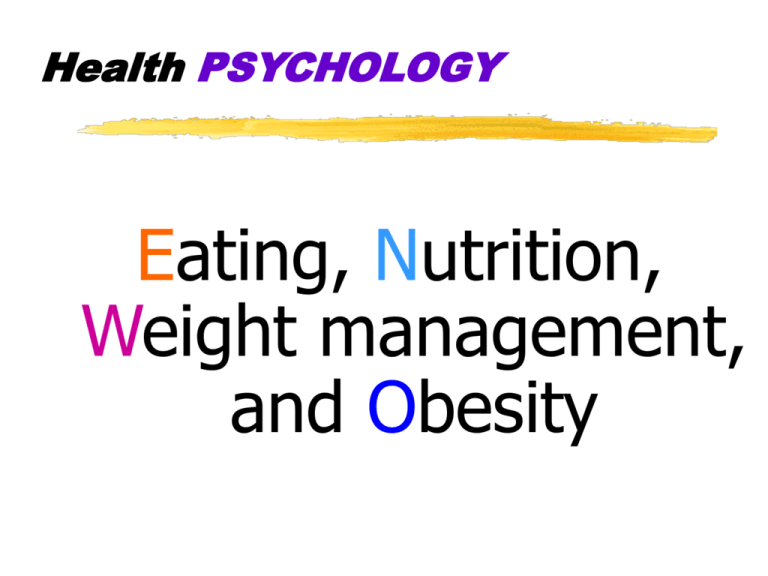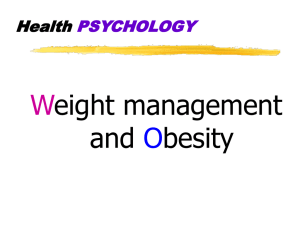Obesity - Warren Wilson Inside Page
advertisement

Health PSYCHOLOGY Eating, Nutrition, Weight management, and Obesity “[People] dig their graves with their own teeth and die more by those fatal instruments than the weapons of their enemies.” -- Thomas Moffett, 1600 Food and Wellness (Psychological and Physical) “What to eat” (M. Nestle) “Positive eating” “In defense of food” (M. Pollan) USDA’s MY Pyramid vs. Healthy Eating Pyramid (Harvard) Slow food, fast food, no food, ??? WHAT’S A PERSON TO DO??!!! Food and Wellness (Psychological and Physical) Nutrition and Wellness Eating to feel well (as opposed to simply getting calories) -- mens sana in corpore sano Eating for psychological and physiological wellness Eating for disease prevention Eating for _________________ (lots of reasons) What we eat Macronutrients Carbohydrates Fats Proteins Micronutrients Vitamins Minerals Phytochemicals What we eat Vitamins 13 known vitamins, classified as either fat-soluble (A, D, E, K) or water-soluble (B and C) C & E are antioxidants Minerals Inorganic elements (e.g., calcium -- for muscle contractions, nerve transmission) Phytochemicals Bioactive chemicals found in plants (e.g., sterols, flavonoids, beta-carotene) with potential healthpromoting qualities (e.g., anti-oxidant activity) How we eat Michael Pollan NYTimes article (quiz) Eat food Mostly plants Not too much Impact of diet on: Heart Disease Cancer Other Conditions Weight Management Caloric needs Vary by age, sex, height, weight, activity level, & basal metabolic rate (BMR) Rough guideline (men = 2500 kcal, women = 2000 kcal) Regular physical activity ENERGY IN ENERGY OUT BODY MASS GENES Assessing body composition Bioelectrical impedance — determining body fat percentage by analyzing electrical resistance (fat is a poor conductor) Hydrostatic weighing — comparing underwater weight with dry weight Body mass index (BMI) – calculating a ratio of height to weight Calculating BMI http://www.nhlbisupport.com/bmi/ BMI Categories: Underweight = <18.5 Normal weight = 18.5-24.9 Overweight = 25-29.9 Obesity = BMI of 30 or greater When we eat too much… or move too little Obesity (particularly “apple-pattern”) linked to atherosclerosis, hypertension, diabetes Increased risk of several cancers, sleep disturbances, degenerative joint disease Impact on psychological well-being Increased mortality rates (next slide) Relationship between BMI and Mortality Factors That Contribute to Obesity Heredity / biological factors Cultural factors Emotional / behavioral factors Hypothalamus and eating Lateral Hypothalamus (LH) Stimulation leads to hunger Lesioning leads to self-starvation Ventromedial Hypothalamus (VMH) VMH lesioning leads to hunger VMH stimulation causes an animal to stop eating Metabolism and weight Basal Metabolic Rate (BMR) base rate of energy expenditure influenced by heredity, age, activity level, and body composition (fat tissue has a lower metabolic rate) Set Point the point at which an individual’s “weight thermostat” is supposedly set when the body falls below this weight, an increase in hunger and a lowered metabolic rate may act to restore the lost weight “Is it genetic?” ob gene Regulates production of leptin Leptin is secreted by fat cells and has dual activity of decreasing food intake and increasing metabolic rate Mice born without the ability to make leptin (ob/ob mice) eat without restraint ob/ob mouse normal mice ob/ob mouse ob/ob mouse ob/ob mouse injected with leptin So, just give obese humans leptin!!! In fact, this works in leptin-deficient humans, but… 99.99% of obese humans have HIGH levels of leptin, but have become insensitive to it. Hereditary factors The genetic contribution to body weight is estimated to be between 40 and 70 percent (with some rare cases of severe obesity linked to specific gene errors) Body weights of adopted children correlate more strongly with weights of biological parents The epigenetics of increasing weight through the generations (“One hypothesis is that maternal obesity before and during pregnancy affects the establishment of body weight regulatory mechanisms in her baby. Maternal obesity could promote obesity in the next generation." (Waterland, 2008) Obesity Trends http://www.cdc.gov/nccdphp/dnpa/obesity/trend/maps/index.htm Go to other PP slide show Will the trend continue? “Most adults in the U.S. will be overweight or obese by 2030, with related health care spending projected to be as much as $956.9 billion, according to researchers at Johns Hopkins (July 2008, online issue of Obesity). Obesity Trends Why? Factors That Contribute to Obesity Heredity / biological factors Cultural factors Emotional / behavioral factors 10,000 years ago – who survived during a famine? ENERGY IN ENERGY OUT Increase in availability of high density foods (sugar/fat are cheap) Decrease in workrelated activities Decrease in activity of daily living Increase in size Decrease in cost BODY MASS Genetic predisposition to store fat Just as our jeans no longer fit our waist, our genes no longer fit our environment Social/Cultural Factors in Obesity We live in a toxic environment. It’s like trying to treat an alcoholic in a town where there’s a bar every ten feet. Bad food is cheap, heavily promoted, and engineered to taste good. Healthy food is hard to get, not promoted, and expensive. If you came down from Mars and saw all this, what else would you predict except an obesity epidemic? Kelly Brownell, Yale, 2004 (Nat’l Geo. Article: The heavy cost of fat) Social/Cultural Factors in Obesity Food-toxic environment (cheap, hi-cal, lo-quality food available) Absence of supermarkets in lo-income neighborhoods Way too many of our calories are coming from junk food (and in the car). (Sugar: 172 lbs/pp per year) Governmental contribution (ABC News video): dependence on Zea Mays (a giant tropical grass) We are simply eating more! (next slide) Humongasize it!! Past Today French Fries 2.4 oz 210 kcal (1955) 7 oz 610 kcal Soda 6.5 oz 79 kcal (1916) 20.0 oz 250 kcal Hershey’s Bar 2 oz 300 kcal (1900) 7 oz 1000 kcal POPCORN 20 Years Ago 270 calories 5 cups Today 1700 calories 21 cups buttered Social/Cultural Factors in Obesity Pounds consumed per person 1970 – 1,497 lbs. 2000 – 1,775 lbs. •2004: The "Monster Thickburger" — two 1/3pound slabs of Angus beef, four strips of bacon, three slices of cheese and mayonnaise on a buttered sesame seed bun •1420 calories! Social/Cultural Factors in Obesity Cultural variation in ideal body image (overemphasis on thinness yo-yo dieting and eventual weight gain) Japanese-American men are 3 times as likely to be obese as men living in Japan Pima Indians (next slide) Social/Cultural Factors in Obesity Pima Indians (in Mexico vs. in U.S.) Emotional / behavioral factors Disinhibition — overeating triggered by an event, emotion, or behavior Eating used as coping Internality / Externality hypothesis Sensitivity to cues Overweight people often more sensitive to external: Time of day Commercials “Golden arches” Dieting concerns Dieting In U.S., 72% of women and 44% of men have dieted at some point in their adult lives Yo-yo dieting associated with progressive wt gain Chronic dieting influence BMR negatively Fad diets and health problems Trend is improving, with fewer people on “diets” these days Healthy Weight Loss Cognitive-behavioral program Goal-setting, monitoring, social support L.E.A.N. Lifestyle changes (stimulus control, selfmonitoring, speed, etc.) Exercise Attitude Nutrition Stepped Care for Obesity






